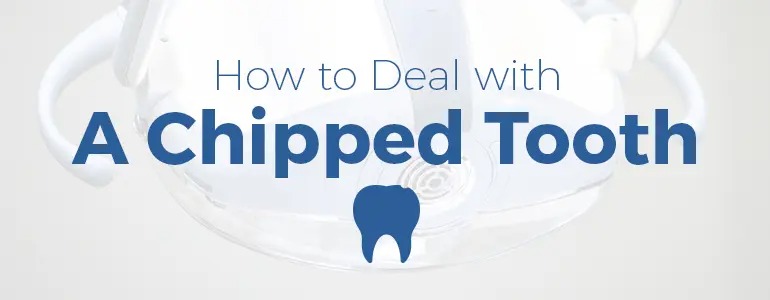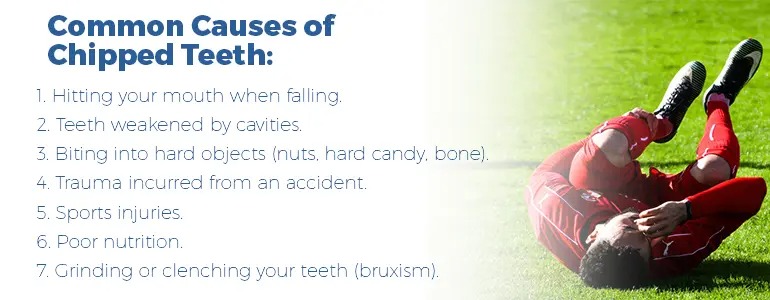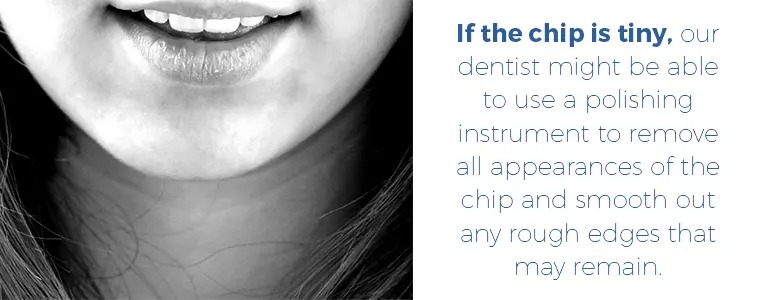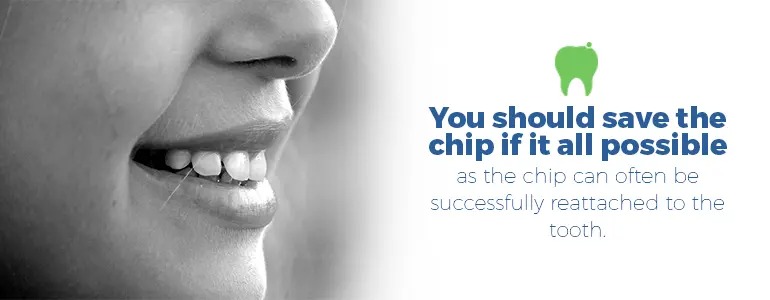
It’s all fun and games until someone ends up with a chipped tooth. How many times have you heard that from either your mom or dad — or both? Now, if you’re a parent, you might be saying those same words to your children.
Chipped teeth are quite common, for adults and children alike, and they’re notably easy to achieve. In fact, it only requires a little bit of contact, the right angle, and no small amount of bad luck for practically anyone to chip a tooth.

Crest reports the following to be among common causes of chipped teeth:
- Hitting your mouth when falling.
- Teeth weakened by cavities.
- Biting into hard objects (nuts, hard candy, bone).
- Trauma incurred from an accident.
- Sports injuries.
Other potential causes include:
- Poor nutrition.
- Grinding or clenching your teeth (bruxism).
This means while they are bothersome, they are dental problems that our cosmetic dentists at AZ Family Dentist have a depth of experience in performing.
The other remarkable thing is that because they are so common, there have been many advances in treatment options over the years. A chipped tooth today can be repaired to the point that it is almost impossible to tell a chip ever existed.
Below you will find a few key details to help you deal with a chipped tooth effectively when the situation calls for it.
What’s the Big Deal About a Chipped Tooth?
Chipped teeth mean different things for different people depending on your ability to tolerate pain and how quickly you respond to the chipped tooth by seeking the appropriate care from our Glendale dentist.
While chipped teeth aren’t necessarily medical emergencies by themselves, they can be cause for concern and should be monitored by our dental professional as quickly after the incident as possible. If your chip is large enough to expose a nerve, the pain of the chipped tooth may be enough to encourage you to seek prompt medical attention. Ignoring a chipped tooth could result in damage to your enamel, tooth sensitivity, and pain. More importantly, when your tooth is broken, the nerve is less protected from bacteria in the mouth, which increases your risk of infection.
If not treated, a chipped tooth can lead to:
- Smile imperfections
- Tooth sensitivity
- Enamel damage
- Tooth pain
- Infection
- Abscess
- Tooth loss
The size of your chip plays a role in the type of dental procedure you’ll need and the damage that can occur to your tooth.
Small Chips
For some residents in Glendale, a chipped tooth only represents an aesthetic dentistry problem. This is usually the case with a minuscule chip in the tooth — one that is not large enough to do damage to the enamel or the sensitive layers beneath your enamel.

If the chip is tiny, our dentist might be able to use a polishing instrument to remove all appearances of the chip and smooth out any rough edges that may remain. Bonding is another option in which our dentist applies materials to the surface of your tooth that help to maintain the structure and appearance of the tooth. Porcelain veneers are another option for chipped teeth.
Just because your chip is small doesn’t mean there is no risk or that you shouldn’t seek dental care in response to your chipped tooth. Getting help, no matter how small the chip happens to be, means you don’t need to be worried about infections and other problems related to the chip. It also means you can preserve the beauty and integrity of your smile, which may be a bigger burden off your shoulders, especially if the chip is located on one of your front teeth.
Medium Chips
If your chip is medium-sized, or large enough to damage some of the layers beneath the enamel, it can pose a risk to your health and the health of your tooth. This is especially the case if you do not seek professional dental care for a chipped tooth quickly enough after the chip occurs.
It only takes a tiny amount of pulp to be exposed for infections to become a likely outcome. This is why it is so critical to see our dentist quickly after the chip occurs. Not only can you avoid infections by seeing our dentist, but you can also deal with the demands of a larger chip to avoid much of the pain these chips commonly cause.
Our dentist can easily repair medium-sized chips — especially if you act swiftly to save the chipped part of the tooth and get in to see our dentist within 24 hours whenever possible. If you cannot find the piece of tooth that was chipped away, hope is not lost. There are other options, including crowns and veneers.
Failing to get prompt treatment once you’ve chipped your tooth, however, can result in a dental infection that can cause substantial pain. Depending on the severity of damage to your tooth, it can result in the need for a root canal.
Large Chips
Large chips often present the biggest potential problems. Aesthetically, they are the most noticeable. This often means you want to tend to them quickly, which is a good thing as they also present the greatest potential for an exposed nerve and potentially excruciating pain.
The key is to get prompt attention from a qualified dental professional. This allows you to receive fast attention and relief from the pain while also helping to increase the likelihood that you can preserve the look of your smile — even if a root canal and crown are required.
In some cases, if the chip is left unattended, it will spread to create a situation in which the tooth cannot be saved — yet another reason to see our dentist promptly whenever a large chip occurs. In these cases, extraction is the only option remaining.
Distinguishing Between a Chipped Tooth and a Broken Tooth
Regardless of whether your tooth is broken or chipped, you should visit us here at AZ Family Dentist. Treatment for either situation depends on how severely your tooth is damaged. If your tooth is chipped and only a small portion of enamel is broken off, your chipped tooth repair can be completed with a dental filling or bonding in one visit to our office.

On the other hand, if you have a broken tooth, we will need to file part of the remaining tooth, and then cover it with a tooth-colored crown. In some broken tooth cases, you may need root canal therapy before your crown placement. Getting a crown typical requires two appointments.
Keep in mind that if your tooth is bleeding, whether chipped or broken, you need to be seen right away. If a small piece chipped off without evidence of bleeding, it’s not an emergency and you can call our office to make an appointment.
What to Do If You Chipped a Tooth
Really and truly, you’ve been through the hard part already. Chipping the tooth can be the most difficult and painful part of the process. If you’re thinking, “I just chipped a tooth, and I have no idea what to do next,” then you’re in the right place to learn about your options.

If you have chipped a tooth, these are the first things to do:
- Rinse your mouth with warm water. This small, first step can help you keep potential irritants from the area around the tooth, clear away any blood, and soothe pain. Be sure to use warm water rather than hot, as you may experience some sensitivity to hot and cold.
- Stop the bleeding. Do this by using a clean gauze and gently applying pressure to the tooth. Rinse and apply new gauze as needed.
- Reduce swelling. Apply an ice pack or cold compress to your face in the area where your tooth is chipped to reduce swelling.
- Relieve the pain. Take an over-the-counter pain reliever to reduce swelling. If bleeding is a problem, avoid aspirin and other pain relievers that may cause blood to flow more freely.
- Protect the tooth. The part of your tooth that remains needs to be protected from further damage or injury. Use dental cement, if available, to protect your tooth until you can get in to see our dentist.
- Shield your tongue and cheeks. Chipped teeth leave behind jagged edges that can cut your tongue or cheeks. Apply dental wax, if available, to the edges of the chip to smooth it out until you can visit our dentist. If dental wax isn’t available, cover the edge with sugarless chewing gum.
- Preserve the chip if possible. According to Harvard Medical School, you should save the chip if it all possible as the chip can often be successfully reattached to the tooth. Preserve the tooth in milk or saliva for avoid it drying out. If you can’t save it, though, it’s no cause for alarm as there are other treatment options availabl
- Visit our dentist quickly. Ideally, you’ll want to visit the dentist within a few hours of the incident. Call our dentist and describe the extent of the damage as well your situation to get advice about your best option and how fast you need to be treated. Chipped teeth can worsen over time. Prompt attention from our dentist can prevent that from happening and save you a fair amount of pain the process.
The next question that comes to mind for many parents relates to baby teeth. You may very well find yourself in this situation more than once as a parent.
My Child Just Chipped a Tooth. Now What?
Every little emergency or uncertainty in life is amplified when it involves your children. Your child will likely be concerned, if not frightened that they chipped one of their teeth. The number one rule of thumb to follow when dealing with a child’s chipped tooth is to remain calm. Not only will it help you to have a clear head, but it will also help your child keep from panicking.
For the most part, a chipped tooth with a child is less of a concern if your child still has baby teeth. Handling a chipped baby tooth for children is much like handling one for adults, though. You will want to follow the same steps mentioned above: warm water rinses, stop the bleeding with gauze, and reduce swelling, relieve the pain, protect the tooth, cheeks, and tongue, etc.
You also want to make an appointment as quickly as possible so our dentist can determine if further action is necessary. It is always in your best interests to err on the side of caution when it comes to your child’s oral health.
Treatment Options for Chipped Teeth
We mentioned the treatment options for chipped teeth above, briefly. This section explains a little more about each of the options commonly used to treat chipped teeth:
- Bonding your teeth involves applying a composite resin to teeth that have become discolored or have been damaged, cracked, or chipped. The resin bonds to the tooth to create a seamless barrier of protection for your tooth that is aesthetically pleasing. Bonding typically lasts 10 years without showing signs of wear or discoloration if you care for your teeth properly.
- Placed over your tooth, a dental crown, or cap, is placed over your tooth, and it looks and behaves like an actual tooth. The purpose is to protect your damaged tooth and the teeth surrounding it from breaking down as they would have over time had the tooth been removed. A crown is applied following a root canal.
- Enamel shaping. Dentists can perform a lesser-known procedure dentists called enamel shaping. Our dentist may choose to use this for smaller chips in your teeth because it’s ideal for reshaping teeth that are oversized, rough, or uneven. This will help to polish your smile and is perfect if you don’t have underlying damage to your tooth.
- Root canal. These are two words that strike fear into the hearts of people everywhere, but root canals are not nearly as ominous as they sound. In fact, modern dentistry has made them practically painless — not to mention far less painless than the pain you will experience from ongoing dental infections or an exposed nerve. The procedure itself removes the infection in your root canal and replaces it with new material that cannot become infected. It is usually followed by a crown to protect what remains of the tooth.
- Tooth Extraction. In some instances, the chip has spread below the surface of your gums, leaving no viable option other than a tooth extraction. While most dentists will move mountains to save a tooth, there are occasions when leaving the tooth in your mouth may have more devastating health consequences than removing it. This is not a decision that should be made lightly, with the possible exception of baby teeth extractions, and it’s one you should thoroughly discuss with our dentist.
- Veneers are a more cosmetic solution to the problem of a chipped tooth. It involves bonding a thin layer of custom-created porcelain or composite resin to the surface of your teeth to improve the cosmetic appearance of your teeth. Veneers can be used to change the overall appearance of your smile and are excellent for hiding chips, cracks, discolorations, gaps, and more. If you’re going to the expense of veneers, porcelain veneers are better choices for mimicking the appearance of natural teeth and are more resistant to stains and discolorations.
A chipped tooth, while it can be disconcerting, and even uncomfortable, is not necessarily the end of your good dental health. However, prompt attention is the real secret to success when it comes to preserving the beauty of your smile and sparing yourself no small degree of pain. Your number one priority is to preserve your tooth and prevent your condition from worsening.
Call us here at AZ Family Dental whenever you experience a chipped tooth in the Glendale, Phoenix, or Peoria area to schedule an emergency procedure and get the swift treatment your smile warrants and deserves. You’ll appreciate the relief that leaving your chipped tooth in our experienced, qualified, and gentle dental professional hands provide.
